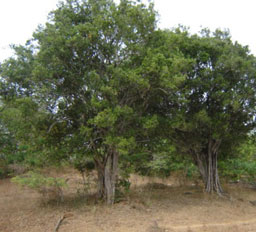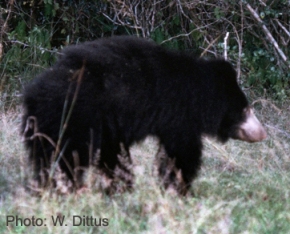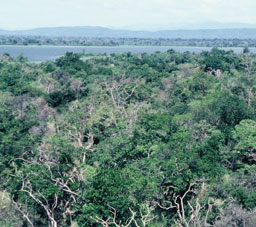
Weera Tree
Ecology of Dry Evergreen Forest
The Dry Zone of Sri Lanka extends from the south-east of the island, all through the eastern and northern lowlands. The natural cover for this expanse is the dry evergreen forest, that varies locally in plant species richness according to rainfall. The driest areas are in the extreme south east (e.g., Ruhunu National Park) and north-west (e.g., Wilpattu National Park) and the Jaffna peninsula.
At Polonnaruwa this forest is fairly diverse and relatively moist. The ecological structure of the forest at Polonnarwua has been studied, especially in relation to cyclonic events (Dittus 1977, 1985). Cyclones have a major impact on the tree species composition of the uppermost forest layer.
Over 63 tree species are found at the study site. Chief among these tree species is weera (Euphorbiaceae: Drypetes sepiara), satin (Meliaceae:Chloroxylon swietenia), banyan (Moraceae: Ficus bengalensis), Ceylon oak (Sapindaceae: Schelichera oleosa), palu (Sapotaceae:Manilkara hexandra), tamarind (Leguminosae: Tamarindus indica), ebony (Ebeneacae: Dyospyros ferrea), kolon (Rubiaceae: Adina cordifolia), strychnos (Loganiaceae: Strychnos potatorum), godakirala (Ulmaceae: Holoptelea integrifolia), and neem (Meliaceae: Azidirachta indica). See Dittus (1977, 1985) for more information.
 History and culture: Initiated in ancient times (1st Century BC), the irrigation network that feeds the reservoirs to the north, were fed by waters diverted from the Amban Ganga. These, more than two thousand years old systems, are still in use today. The site of Buduruwayaya in the SW corner of the park, is a large archaeological complex of temples and Buddha statues. One of the key battles, in the 2nd Century BC, between the kings Dutugemunu and Elara occurred at Yudaganawa in the SE corner of the park. In recent history, the park began as a hunting reserve in 1907 and therefore has a long period of protection.
History and culture: Initiated in ancient times (1st Century BC), the irrigation network that feeds the reservoirs to the north, were fed by waters diverted from the Amban Ganga. These, more than two thousand years old systems, are still in use today. The site of Buduruwayaya in the SW corner of the park, is a large archaeological complex of temples and Buddha statues. One of the key battles, in the 2nd Century BC, between the kings Dutugemunu and Elara occurred at Yudaganawa in the SE corner of the park. In recent history, the park began as a hunting reserve in 1907 and therefore has a long period of protection. Wildlife: Being a relatively moist and closed forest habitat, the park supports a fairly high density of animals native to the dry zone. Elephants (estimated at about 150 individuals), that prefer grassland habitats are present in the park, but are not as numerous as in other parks where more extensive grasslands prevail. Among the large mammals, bears are fairly common. All animals common to the dry zone are found here.
Wildlife: Being a relatively moist and closed forest habitat, the park supports a fairly high density of animals native to the dry zone. Elephants (estimated at about 150 individuals), that prefer grassland habitats are present in the park, but are not as numerous as in other parks where more extensive grasslands prevail. Among the large mammals, bears are fairly common. All animals common to the dry zone are found here.
Angamedilla National Park
- Area: about 75 km2,
- Status: established 06 June 2006.
- Main entrance: from Angamedilla village and anicut.
- Travel time by road from PRS (monkey camp): 30 min. The park lies opposite the Smithsonian Research Station, and also can be accessed from there by boat.
Geography and habitat: This park is the northern contiguous extension of the Wasgamuwa NP. The Sudukanda mountain range cuts through the park from south to north. The western boundary is marked by the Elahera Yoda-ela stream and by the Parakrama Samudra lake in the east. It is a dry evergreen forests that serves as a catchment for the Parkrama Samudra lake. Most of the forest is secondary scrub with weera trees (Drypetes sepiara) the most common. Some riverine forests occurs along the anicut and irrigation channel to the Parakrama Samudra lake. A stream, the Radavige Oya, supports a narrow belt of riverine forest.
History and culture: The Angamedilla anicut was built by king Parkrama Bahu in the 11th Century AD, and diverts water from the Amban Ganga river for more than 15 km along man-made channels, northward to feed the Parakarama Samudra reservoir. The ancient stonework of the anicut is located near the entrance gate to the park. Minor archaeological remains can be found scattered throughout the park.

